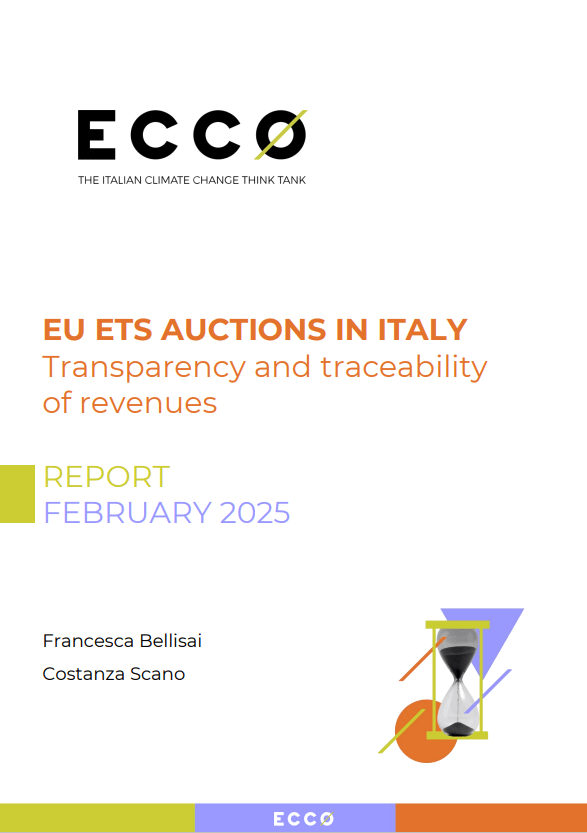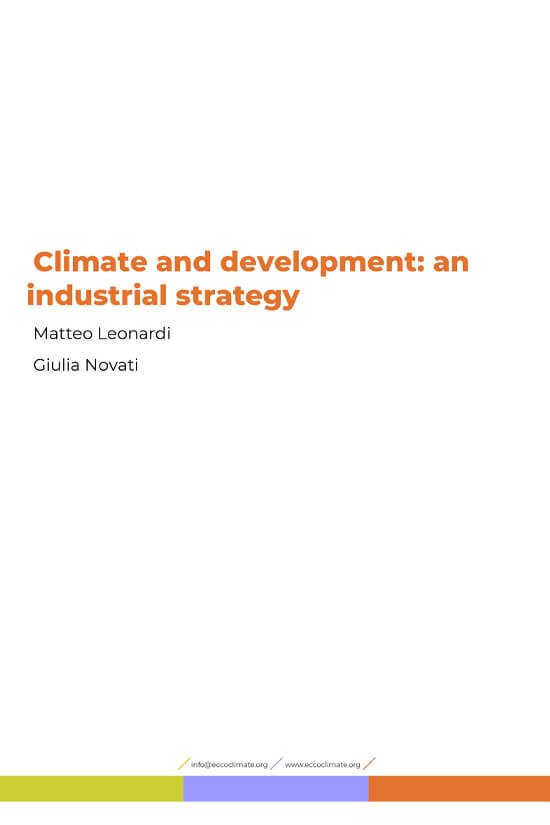Publications
Search
Filters
Authors
/ Alexandra Scott
/ Andrea Ghianda
/ Annalisa Perteghella
/ Beatrice Moro
/ Carolina Bedocchi
/ Caterina Molinari
/ Chiara Di Mambro
/ Chiara Mariotti
/ Chloe Pagliaro
/ Costanza Scano
/ Davide Panzeri
/ ECCO think thank
/ Eleonora Cogo
/ Federico Tassan-Viol
/ Filomena Annunziata
/ Francesca Andreolli
/ Francesca Bellisai
/ Gabriele Cassetti
/ Giovanni D'Amico
/ Giulia Colafrancesco
/ Giulia Giordano
/ Giulia Novati
/ Giulia Signorelli
/ Ilaria Mazzocco
/ Lorena Stella Martini
/ Luca Bergamaschi
/ Luca Iacoboni
/ Mario Noera
/ Marta Lovisolo
/ Massimiliano Bienati
/ Matteo Leonardi
/ Matteo Viola
/ Michele Governatori
/ Nicolas Drago
Decarbonising the industrial sector requires a targeted approach, with solutions that in most cases must be tailored to meet the needs of each industry. Amongst these, electrification appears to be the most competitive option and the only one capable of aligning decarbonisation objectives with energy security needs. This report presents the results of a specific feasibility study on the electrification of two key sectors in the Italian manufacturing industry: food and textiles.
An analysis of the public reports submitted by Italy to the European Commission between 2014 and 2024 highlights issues with the use of revenues generated from EU ETS auctions. Reviewing the revenues from the ETS auctions reveals significant shortcomings in expenditure planning and fund traceability, with only nine percent of the revenues generated by the system have been allocated to measures addressing climate change.
The drive to innovate that has resulted from the need to meet today’s decarbonisation objectives has
given rise to a new industrial revolution based on clean technology. This policy briefing, which analyses the current situation in relation to public procurement legislation in Europe and Italy, sets out a proposal for revising the minimum environmental criteria for the public procurement of construction materials, which are currently under review.
This analysis proposes a simplified and aggregated policy framework that’s consistent with the transition towards climate neutrality as well as an outline and assessment of the policies currently in place in the cement industry in Italy, which is the second largest producer of cement in the European Union and a major consumer of cement and concrete.
The biggest obstacle for zero/low emission or green steel is the simple fact that, within the current market, it isn’t cost-competitive. In light of the complex regulatory framework that has been developed around energy and climate objectives, this policy paper offers a perspective and a conceptual outline for defining a policy framework that’s consistent with the country's emission reduction goals.
The significant contribution to national emissions by the manufacturing sector depends on its reliance on the use of fossil fuels for energy purposes, as well as on emissions that are inherent in certain production processes (e.g. cement, chemicals, etc.). Framing the country’s industrial development prospects within the path of reducing greenhouse gas emissions represents a strategic opportunity. The definition of the National Energy and Climate Plan (NECP) due by next June, is a unique opportunity for action.
The increasing production and the pace of penetration of clean technologies required to a radical transformation of the global energy system critically depend on the availability of critical minerals.
The high geographic fragmentation of mining activities and the Asian dominance in the processing and refining stages of critical minerals require a progressive diversifying, reshaping and strengthening of the global supply chain structure in order to manage supply risks.
The aim of this paper is to provide an overview of the technologies available for the decarbonization of the steel sector in Italy and to identify a decarbonization path in response, on the one hand, to the risks of de-industrialization and, on the other, to the risks of lock-in of investments in supply chains that are not compatible with the net zero emissions perspective.
The report analyzes critical issues, solutions and future scenarios to promote a decarbonization of the plastics supply chain that will allow the sector to remain competitive and, at the same time, remain aligned with the 2050 climate neutrality goals.
Italy is the second largest steel producer in Europe and the 11th largest in the world. In 2019, 23.2 Mt of steel was produced at the Acciaierie d'Italia plant in Taranto (Ex Ilva). In this report we take an in-depth look at steel production in Italy, analyzing the specific case of the only Italian plant that currently produces it, namely the Taranto steel plant
Full decarbonization by 2050 requires the development of new industrial strategies aligned with climate goals. In this study, we delve into emission reduction technology options and suggest industrial decarbonization strategies to address climate change through the levers of innovation, welfare, and employment.
Decarbonising the industrial sector requires a targeted approach, with solutions that in most cases must be tailored to meet the needs of each industry. Amongst these, electrification appears to be the most competitive option and the only one capable of aligning decarbonisation objectives with energy security needs. This report presents the results of a specific feasibility study on the electrification of two key sectors in the Italian manufacturing industry: food and textiles.
An analysis of the public reports submitted by Italy to the European Commission between 2014 and 2024 highlights issues with the use of revenues generated from EU ETS auctions. Reviewing the revenues from the ETS auctions reveals significant shortcomings in expenditure planning and fund traceability, with only nine percent of the revenues generated by the system have been allocated to measures addressing climate change.
The drive to innovate that has resulted from the need to meet today’s decarbonisation objectives has
given rise to a new industrial revolution based on clean technology. This policy briefing, which analyses the current situation in relation to public procurement legislation in Europe and Italy, sets out a proposal for revising the minimum environmental criteria for the public procurement of construction materials, which are currently under review.
This analysis proposes a simplified and aggregated policy framework that’s consistent with the transition towards climate neutrality as well as an outline and assessment of the policies currently in place in the cement industry in Italy, which is the second largest producer of cement in the European Union and a major consumer of cement and concrete.
The biggest obstacle for zero/low emission or green steel is the simple fact that, within the current market, it isn’t cost-competitive. In light of the complex regulatory framework that has been developed around energy and climate objectives, this policy paper offers a perspective and a conceptual outline for defining a policy framework that’s consistent with the country's emission reduction goals.
The significant contribution to national emissions by the manufacturing sector depends on its reliance on the use of fossil fuels for energy purposes, as well as on emissions that are inherent in certain production processes (e.g. cement, chemicals, etc.). Framing the country’s industrial development prospects within the path of reducing greenhouse gas emissions represents a strategic opportunity. The definition of the National Energy and Climate Plan (NECP) due by next June, is a unique opportunity for action.
The increasing production and the pace of penetration of clean technologies required to a radical transformation of the global energy system critically depend on the availability of critical minerals.
The high geographic fragmentation of mining activities and the Asian dominance in the processing and refining stages of critical minerals require a progressive diversifying, reshaping and strengthening of the global supply chain structure in order to manage supply risks.
The aim of this paper is to provide an overview of the technologies available for the decarbonization of the steel sector in Italy and to identify a decarbonization path in response, on the one hand, to the risks of de-industrialization and, on the other, to the risks of lock-in of investments in supply chains that are not compatible with the net zero emissions perspective.
The report analyzes critical issues, solutions and future scenarios to promote a decarbonization of the plastics supply chain that will allow the sector to remain competitive and, at the same time, remain aligned with the 2050 climate neutrality goals.
Italy is the second largest steel producer in Europe and the 11th largest in the world. In 2019, 23.2 Mt of steel was produced at the Acciaierie d'Italia plant in Taranto (Ex Ilva). In this report we take an in-depth look at steel production in Italy, analyzing the specific case of the only Italian plant that currently produces it, namely the Taranto steel plant
Full decarbonization by 2050 requires the development of new industrial strategies aligned with climate goals. In this study, we delve into emission reduction technology options and suggest industrial decarbonization strategies to address climate change through the levers of innovation, welfare, and employment.










